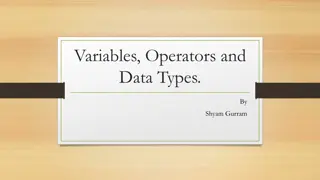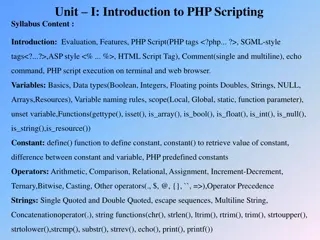
Understanding PHP Operators: Categorized Overview with Examples
Dive into the world of PHP operators with a comprehensive overview presented by Mrs. RautAarti P., Assistant Professor at Deogiri College, Aurangabad. Explore various categories including Arithmetic, Assignment, Bitwise, Comparison, and more. Learn about Unary, Binary, and Ternary operators with detailed explanations and examples.
Download Presentation

Please find below an Image/Link to download the presentation.
The content on the website is provided AS IS for your information and personal use only. It may not be sold, licensed, or shared on other websites without obtaining consent from the author. If you encounter any issues during the download, it is possible that the publisher has removed the file from their server.
You are allowed to download the files provided on this website for personal or commercial use, subject to the condition that they are used lawfully. All files are the property of their respective owners.
The content on the website is provided AS IS for your information and personal use only. It may not be sold, licensed, or shared on other websites without obtaining consent from the author.
E N D
Presentation Transcript
PHP Operators Presented by Mrs. RautAarti P. Assistant Professor Department of Comp. Sci. & IT. Deogiri College, Aurangabad
PHP Operators PHP Operator is a symbol i.e used to perform operations on operands. operators are used to perform operations on variables or values. PHP Operators can be categorized in following forms: Arithmetic Operators Assignment Operators Bitwise Operators Comparison Operators Incrementing/Decrementing Operators Logical Operators String Operators
Conti.. Array Operators Type Operators Execution Operators Error Control Operators We can also categorize operators on behalf of operands. They can be categorized in 3 forms: Unary Operators: works on single operands such as ++, -- etc Binary Operators: works on two operands such as binary +, -, *, / etc. Ternary Operators: works on three operands such as "?:".
1)Arithmetic Operators The PHP arithmetic operators are used to perform common arithmetic operations such as addition, subtraction, etc. with numeric values. Operator Name Example Explanation + Addition $a + $b Sum of operands - Subtraction $a - $b Difference of operands * Multiplication $a * $b Product of operands / Division $a / $b Quotient of operands % Modulus $a % $b Remainder of operands ** Exponentiation $a ** $b $a raised to the power $b
2)Assignment Operators The assignment operators are used to assign value to different variables. The basic operator is "=". Opera Name Example Explanation = Assign $a = $b The value of right operand is assigned to the left operand. += Add then Assign $a += $b Addition same as $a = $a + $b -= Subtract then Assign $a -= $b Subtraction same as $a = $a - $b *= Multiply then Assign $a *= $b Multiplication same as $a = $a * $b /= Divide then Assign (quotient) $a /= $b Find quotient same as $a = $a / $b %= Divide then Assign (remainder) $a %= $b Find remainder same as $a = $a % $b
3) Bitwise Operators The bitwise operators are used to perform bit-level operations on operands. These operators allow the evaluation and manipulation of specific bits within the integer. Ope Name Example Explanation & And $a & $b Bits that are 1 in both $a and $b are set to 1, otherwise 0. | Or (Inclusive or) $a | $b Bits that are 1 in either $a or $b are set to 1 ^ Xor (Exclusive or) $a ^ $b Bits that are 1 in either $a or $b are set to 0. ~ Not ~$a Bits that are 1 set to 0 and bits that are 0 are set to 1 << Shift left $a << $b Left shift the bits of operand $a $b steps >> Shift right $a >> $b Right shift the bits of $a operand by $b number of places
4)Comparison Operators Comparison operators allow comparing two values, such as number or string. ope Name Ex Explanation == Equal $a == $b Return TRUE if $a is equal to $b === Identical $a === $b Return TRUE if $a is equal to $b and they are of same data type !== Not identical $a !== $b Return TRUE if $a is not equal to $b, and they are not of same data type != Not equal $a != $b Return TRUE if $a is not equal to $b <> Not equal $a <> $b Return TRUE if $a is not equal to $b < Less than $a < $b Return TRUE if $a is less than $b > Greater than $a > $b Return TRUE if $a is greater than $b <= Less than or equalto $a <= $b Return TRUE if $a is less than or equal $b >= Greaterthan or equalto $a >= $b Return TRUE if $a is greater than or equal $b
5)Incrementing/Decrementing Operators The increment and decrement operators are used to increase and decrease the value of a variable. Operator Name Example Explanation ++ Increment ++$a Increment the value of $a by one, then return $a $a++ Return $a, then increment the value of $a by one -- decrement --$a Decrement the value of $a by one, then return $a $a-- Return $a, then decrement the value of $a by one
6)Logical Operators The logical operators are used to perform bit-level operations on operands. These operators allow the evaluation and manipulation of specific bits within the integer. Operator Name Example Explanation and And $a and $b Return TRUE if both $a and $b are true Or Or $a or $b Return TRUE if either $a or $b is true xor Xor $a xor $b Return TRUE if either $ or $b is true but not both ! Not ! $a Return TRUE if $a is not true && And $a && $b Return TRUE if either $a and $b are true || Or $a || $b Return TRUE if either $a or $b is true
7) String Operators The string operators are used to perform the operation on strings. Operator Name Example Explanation . Concatenation $a . $b Concatenate both $a and $b .= Concatenation and Assignment $a .= $b First concatenate $a and $b, then assign the concatenated string to $a, e.g. $a = $a . $b
8) Array Operators The array operators are used in case of array. Basically, these operators are used to compare the values of arrays. Ope Name Example Explanation + Union $a + $b Union of $a and $b == Equality $a == $b Return TRUE if $a and $b have same key/value pair != Inequality $a != $b Return TRUE if $a is not equal to $b === Identity $a === $b Return TRUE if $a and $b have same key/value pair of same type in same order !== Non-Identity $a !== $b Return TRUE if $a is not identical to $b <> Inequality $a <> $b Return TRUE if $a is not equal to $b
9) Type Operators The type operator instanceof is used to determine whether an object, its parent and its derived class are the same type or not. Basically, this operator determines which certain class the object belongs to. It is used in object-oriented programming. Eg: $charu=new Developer(); if( $charu instanceof Developer) { echo "Charu is a developer."; } else { echo "Charu is a programmer."; }
10) Execution Operators PHP has an execution operator backticks (``). backticks (``) are not single-quotes. PHP executes the content of backticksas a shell command. Execution operator and shell_exec() give the same result. Operator Name Example Explanation `` backticks echo `dir`; Execute the shell command and return the result. Here, it will show the directories available in current folder.
11) Error Control Operators PHP has one error control operator, i.e., at (@) symbol. Whenever it is used with an expression, any error message will be ignored that might be generated by that expression. Operator Name Example Explanation @ at @file ('non_existent_file') Intentional file error
Expression Almost everything in a PHP script is an expression. Anything that has a value is an expression. An expression is a bit of PHP that can be evaluated to produce a value.The simplest expressions are literal values and variables. A literal value evaluates to itself, while a variable evaluates to the value stored in the variable. More complex expressions can be formed using simple expressions and operators. assignment statement ($x=100), a literal value, a function or operands processed by operators is an expression, anything that appears to the right of assignment operator (=). Example: $x=100; //100 is an expression $a=$b+$c;
Expression with ++ and -- operators These operators are called increment and decrement operators . They are unary operators, needing just one operand and can be used in prefix or postfix manner, although with different effect on value of expression Both prefix and postfix ++ operators increment value of operand by 1 (whereas -- operator decrements by 1). Example: <?php $x=10; $y=$x++; //equivalent to $y=$x followed by $x=$x+1 echo "x = $x y = $y"; ?>
Expression with Ternary conditional operator Ternary operator has three operands. First one is a logical expression. If it is TRUE, second operand expression is evaluated otherwise third one is evaluated. Example: <?php $marks=60; $result= $marks<50 ? "fail" : "pass"; echo $result; ?>
PHP Constants PHP constants are name or identifier that can't be changed during the execution of the script. PHP constants can be defined by 2 ways: Using define() function Using const keyword Constants are similar to the variable except once they defined, they can never be undefined or changed. They remain constant across the entire program. PHP constants follow the same PHP variable rules. For example, it can be started with a letter or underscore only. Conventionally, PHP constants should be defined in uppercase letters.
PHP constant: define() Use the define() function to create a constant. It defines constant at run time. Syntax: define(name, value, case-insensitive) name: It specifies the constant name. value: It specifies the constant value. case-insensitive: Specifies whether a constant is case- insensitive. Default value is false. It means it is case sensitive by default.
PHP constant: const keyword PHP use a keyword const to create a constant. The const keyword defines constants at compile time. It is a language construct, not a function. The constant defined using const keyword are case- sensitive. Example: <?php const MESSAGE="Helloconst by PHP"; echo MESSAGE; ?>
Constant() function There is another way to print the value of constants using constant() function instead of using the echo statement. Syntax constant (name) Example: <?php define("MSG", Helllo"); echo MSG, "</br>"; echo constant("MSG"); //both are similar ?>






















